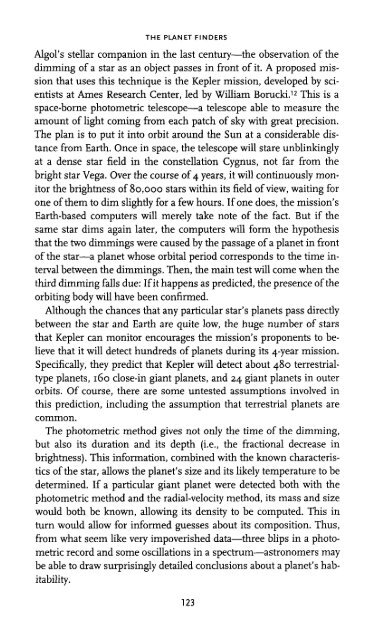You also want an ePaper? Increase the reach of your titles
YUMPU automatically turns print PDFs into web optimized ePapers that Google loves.
HERE BE DRAGONS<br />
tions ago. If we focus entirely on this gene, we can construct an evolutionary<br />
tree that links all the affected individuals to that immigrant,<br />
who becomes their "last common ancestor." But this ignores the fact<br />
that, thanks to sexual reproduction, each of us inherits one half of our<br />
genes from each of two parents, one quarter from each of four grandparents,<br />
and so on. Thus, if we select a different gene to study, that immigrant<br />
will almost certainly not be the common ancestor of all the<br />
affected individuals; in fact, he or she may not show up as an ancestor<br />
to any of them.<br />
Thanks to the development of rapid gene-sequencing techniques, it<br />
has recently become possible to determine the sequences of many<br />
genes across different species. In fact, as of this writing, researchers<br />
have sequenced the complete genomes of fifteen organisms, including<br />
bacteria, archaea, and two eukaryotes (a yeast and a microscopic<br />
worm). It turns out that, indeed, evolutionary trees based on different<br />
genes are different from each other. If one focuses on genes that play<br />
a role in the copying of DNA into RNA and protein ("informational<br />
genes"), for example, one gets trees in which eukaryotes are more<br />
closely related to archaea than to bacteria, as in the i6s TRNA tree. If,<br />
however, one focuses on the much more numerous genes that code<br />
for enzymes involved in regular metabolism ("operational genes"),<br />
one gets trees in which eukaryotes are more closely related to bacteria.<br />
There can only be one true history of evolution. Therefore, the<br />
metaphor of the "tree," while it may apply to single genes, seems not<br />
to adequately describe the evolution of organisms. Rather, we have to<br />
acknowledge that something analogous to sex happens, not just<br />
within species, but between species. Individual species must sometimes<br />
acquire their genetic endowment from more than one parent<br />
species. Instead of always diverging, the paths of evolution also sometimes<br />
rejoin, and the appropriate metaphor for evolutionary history<br />
may not be a "tree" but a "braided channel."<br />
Transfer of genes between different species is, in fact, a well-documented<br />
phenomenon. Bacteria belonging to different species can<br />
pass genes for antibiotic resistance among each other, for example.<br />
One bacterium, Agrobacter tumefaciens, can insert foreign genes into<br />
the genomes of crop plants—it is much used in genetic engineering.<br />
And retroviruses such as HIV (human immunodeficiency virus) can<br />
insert genes into the genome of human cells (although not into<br />
germ-line cells). Thus, one way out of the paradox of the evolutionary<br />
data is to say that the "last common ancestor" was not a single<br />
58













